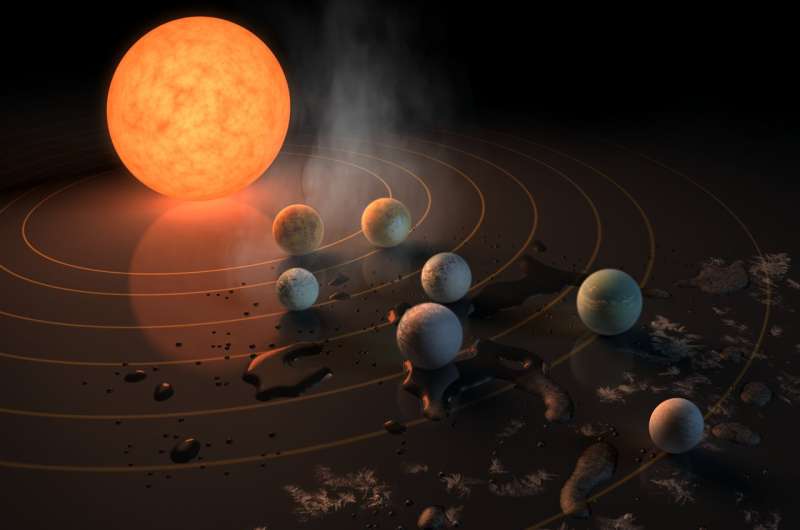Astronomers explain the formation of seven exoplanets around Trappist-1

Astronomers from the University of Amsterdam have offered an explanation for the formation of the Trappist-1 planetary system. The system has seven planets as big as the Earth that orbit close to their star. The crux, according to the researchers from the Netherlands, is the line where ice changes in water. Near that ice line, pebbles that drifted from outer regions to the star receive an additional portion of water and clot together to form proto-planets. The article with the model has been accepted for publication in the journal Astronomy & Astrophysics.
In February 2017, an international team of astronomers announced the discovery of a system of seven exoplanets around a small star, Trappist-1 (see report on eso.org). It was against the prevailing theories of planet formation that so many relatively large planets orbited so close around a small star. Researchers from the University of Amsterdam now come up with a model that explains how the planetary system could have originated.
Until now, there were two prevailing theories for the formation of planets. The first theory assumes that planets are formed more or less on the spot where they are now. With Trappist-1, that is unlikely because the disk from which the planets had originated should have been very dense. The second theory assumes that a planet forms much further out in the disk and migrates inward afterwards. This theory also causes problems with Trappist-1 because it does not explain why the planets are all about the same size as the Earth.
Now, the Amsterdam researchers come up with a model where pebbles migrate instead of complete planets. The model begins with pebbles that are floating from outside regions to the star. Such pebbles consist largely of ice. When the pebbles arrive near the so-called ice line, the point where it is warm enough for liquid water, they get an additional portion of water vapor to process. As a result, they clot together into a proto-planet. Then the proto-planet moves a little closer to the star. On its way it sweeps up more pebbles like a vacuum cleaner, until it reaches the size of the Earth. The planet then moves in a little further and makes room for the formation of the next planet.
The crux, according to the researchers, is in the clotting of pebbles near the ice line. By crossing the ice line, pebbles lose their water ice. But that water is re-used by the following load of pebbles that is drifting from the outer regions of the dust disk. At Trappist-1, this process repeated until seven planets were formed.
Research leader Chris Ormel (University of Amsterdam): "For us, Trappist-1 with its seven planets, came as a welcome surprise. We have been working on pebble aggregation and sweepup by planets for a long time and were also developing a new ice-line model. Thanks to the discovery of Trappist-1 we can compare our model with reality."
In the near future, the Amsterdam researchers want to refine their model. They will run computer simulations to see how their model withstands different initial conditions.
The researchers still expect some discussion among fellow astronomers. The model is quite revolutionary because the pebbles travel from the outer part of the disk to the ice line without much activity in between. Ormel: "I hope that our model will help answer the question about how unique our own solar system is compared to other planetary systems."
More information: "Formation of TRAPPIST-1 and other compact systems." Chris W. Ormel, Beibei Liu & Djoeke Schoonenberg. Accepted for publication in Astronomy & Astrophysics. doi.org/10.1051/0004-6361/201730826 . Preprint: arxiv.org/abs/1703.06924
Journal information: Astronomy & Astrophysics
Provided by Netherlands Research School for Astronomy



















